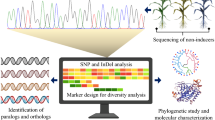Summary
To investigate the mechanisms of seed failure in intraspecific and interspecific crosses of Solanum two diploid, S. commersonii and Group Phureja, and one tetraploid species, S. acaule, species were crossed and the seeds were analyzed for embryo and endosperm development. Many seeds of certain crosses observed seven days after pollinations were found to contain abnormal embryos and degenerating endosperms. In some cases seeds contained an embryo with no endosperm, or an endosperm with no embryo. Other interspecific crosses which were predicted to fail actually produced seeds with normally developed embryos and endosperms. To further characterize the intra- and interspecific embryos and endosperms the nuclear DNA was measured. There are several ways to explain the ploidy levels of embryos and endosperms among the crosses, the occurrence of unreduced gametes in some cases and genomic instability in other cases. The latter resulted in chromosome loss at meiotic and mitotic divisions. Genomic balance in interspecific seeds is critical to both embryo and endosperm development.
Similar content being viewed by others
References
Berlyn GP, Miksche JP (1976) Botanical microtechniques and cytochemistry. Iowa State Univ Press, Ames, Iowa
Bhaduri PN (1936) Studies on the embrogeny of the Solanaceae. Bot Gaz 98:238–295
Brink RA, Cooper DC (1939) Somatoplastic sterility in Medicago sativa. Science 90:545–546
Brink RA, Cooper DC (1944) Hybrids between Hordeum jubatam and Secale cereale failed as seeds early in development due to endosperm breakdown. J Hered 35:67–75
Brink RA, Cooper DC (1947) The endosperm in seed development. Bot Rev 13:423–541
Cooper DC, Brink RA (1945) Seed collapse following matings between diploid and tetraploid races of Lycopersicon pinpinelifolium. Genetics 30:376–400
Correll DS (1962) The potato and its wild relatives. Texas Res Found, Renner TX
Davies DR (1960) The embryo culture of interspecific hybrids of Hordeum. New Phytol 59:9–14
Dixon NJ, Massesy FJ Jr (1957) Introduction to statistical analysis. McGraw-Hill, New York
Ehlenfeldt MK, Hanneman RE Jr (1984) The use of endosperm balance number and 2n gametes to transfer exotic germplasm in potato. Theor Appl Genet 68:155–161
Estrada RN (1984) Acaphu: a tetraploid fertile breeding line, selected from an S. acaule × S. phureja cross. Am Pot J 61:1–7
Hanneman RE Jr (1984) Assignment of endosperm balance numbers (EBN) to the tuber-bearing Solanum species. Res Prog Rep to NCR-84, Pot Gen Tech Comm, Dec
Howard HW (1939) The size of seeds in diploid and auto-tetraploid Brassica oleracea L. Genetics 38:325–340
Johnston SA, den Nijs T, Peloquin SJ, Hanneman RE (1980) The significance of genic balance to endosperm development in interspecific crosses. Theor Appl Genet 56:293–297
Johnston SA, Hanneman RE Jr (1982) Manipulations of endosperm balance number overcome crossing barriers between diploid Solanum species. Science 217:446–448
Kho YO, Baer J (1968) Observing pollen tubes by means of fluorescence. Euphytica 17:298–302
Laibach F (1925) Das Taubwerden von Bastardsamen und die künstliche Aufzucht früh absterbender Bastardembryonen. Z Bot 17:417–459
Laibach F (1929) Ectogenesis in plants. J Hered 20:201–208
Lin B-Y (1975) Parental effects on gene expression in maize endosperm development. PhD Thesis, University of Wisconsin
Marks GE (1966) The enigma of triploid potatoes. Euphytica 15:205–209
Muntzing A (1933) Studies on meiosis in diploid and triploid Solanum tuberosum. Hereditas 17:223–245
Olah L von (1938) Cytological investigations on the genus Solanum Sect. Tuberarium III. S. commersonii Dun. and some of its hybrids. Z Vererbungsl 74:228–241
Phillips RL, Wang AS, Kowles RV (1983) Molecular and developmental cytogenetics of gene multiplicity in maize. In: Gustafson JP (ed) Stadler Symp No 15. University of Missouri, Columbia MO
Rammanna MS, Hermsen JGTh (1971) Somatic chromosome elimination and meiotic chromosome pairing in the triple hybrid 6X-(Solanum acaule × S. bulbocastanum) × 2X-S. phurja. Euphytica 20:470–481
Rowe PR (1974) Parthenogenesis following interspecific hybridization. In: Kasha KJ (ed) Haploids in higher plants. University of Guelph, Guelph, Canada
Rybin VA (1933) Cytological investigation of the South American cultivated and wild potatoes and its significance for plant breeding. Bull Appl Bot, Genet Plant-Breed, Leningrad, Ser 2:3–100
Sheridan WF (1982) Maize developmental mutants. J Hered 73:318–329
Smith PG (1944) Embryo culture of a tomato species hybrid. Proc Am Hortic Sci 44:413–416
Smith JA, Desborough SL (1985) Characterization of proteins extracted from seeds of Solanum species (in preparation)
Stelly DM, Peloquin SJ, Palmer RG, Crane CF (1984) Mayer's hemalum-methyl salicylate: A stain-clearing for observations within whole ovules. Stain Technol 59:155–161
Stephens SG (1942) Colchicine produced polyploids in Gossypium. 1. An autotetraploid Asiatic cotton and certain of its hybrids with diploid species. J Genet 47:272–295
Valentine DH (1947) Studies in British Primulas. 1. Hybridization between Primrose and Oxlip (Primula vulgaris Huds. and P. elatior Schreb.). New Phytol 46:229–253
Valentine DH (1952) Studies in British Primulas. 3. Hybridization between Primula elatior L. Hill and P. veris L. New Phytol 50:383–399
Valentine DH (1955) Studies in British Primulas. 4. Hybridization between Primula vulgaris Huds. and P. veris L. New Phytol 54:70–80
Valentine DH (1956) Studies in British Primulas. 5. The inheritance of seed compatibility. New Phytol 55:305–318
Woodell SRJ (1960a) Studies in British Primulas. 7. Development of seed from reciprocal crosses between P. vulgaris Huds. and P. veris L. New Phytol 59:302–313
Woodell SRJ (1960b) Studies in British Primulas. 8. Development of seed from reciprocal crosses between P. vulgaris Huds. and P. veris L. and P. elatior (L.) Hill: and between P. veris L. and P. elatior (L.) Hill. New Phytol 59:314–325
Woodell SRJ, Valentine DH (1960) Studies in British Primulas. 9. Seed incompatibility in diploid-autoploid crosses. New Phytol 59:282–294
Wangenheim KH von, Peloquin SJ, Hougas RW (1960) Embryological investigations on the formation of haploids in the potato (Solanum tuberosum). Z Vererbungsl 91:391–399
Author information
Authors and Affiliations
Additional information
Communicated by H.F.Linskens
Scientific Journal Series Article No. 14636 of the Minnesota Experiment Station
Rights and permissions
About this article
Cite this article
Smith, J.A., Desborough, S.L. An interpretation of genomic balance in seed formation in interspecific hybrids of Solanum . Theoret. Appl. Genetics 72, 346–352 (1986). https://doi.org/10.1007/BF00288571
Received:
Accepted:
Issue Date:
DOI: https://doi.org/10.1007/BF00288571




